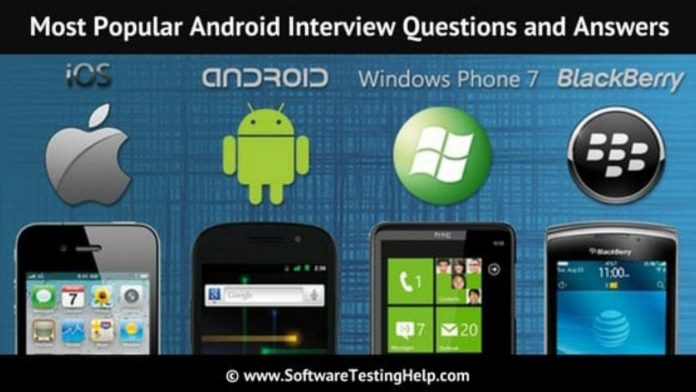If you are a software engineer or in a field related to software development, you might have had a dream of working for Android. Android is one of the most common OS that you can think of. The operating system is so popular, and in every five people, you might find three of them have a mobile with an Android operating system. Working here is a dream job for many, and that means you need to be well prepared and know almost everything about the OS. When looking for a job at any place, you often get asked several interview questions for several reasons. Firstly interview questions help in connecting you to the employee and the employer, and also, it helps a lot in ensuring the employer selects the right candidate for the job.
Therefore, if you want to be among the people who they chose for the post, you need to be very prepared for any question they might ask. In this article, we have compiled some of the most asked Android interview questions to help give you an insight into how the interview goes.
Table of Contents
1. Can you define Android OS?
It’s an operating system that uses open-source code and commonly used in mobile devices. The Android operating system has lots of components allowing it to perform basic and advanced
functions. This is one of the widely asked Android interview questions all the time.
2. Can you name the latest version of Android?
The new version of Android is the Android 10.0 version that was around seven months ago. This question can catch you off guard during the Android interview questions if you are not up to date.
3. Can you state some features of Android?
This is something you need to have on your fingertips. The standard features are; it’s open-source, supports messaging services, web, media, and more. You can also customize the operating system. These are just a few, and you need to know more about the right preparations all the time.
4. What is the definition of AAPT?
If there is something you need to be keen about when it comes to Android interview questions, it’s the abbreviations. This is a tool Android Asset Packaging Tool that offers a developer the ability to work with zip files by extracting or even viewing them.
5. Can you define the Android architecture?
Android architecture refers to the layers of Android stack, and each has a service it does to the layer on top of it. There are four significant layers of Android, and they are; Linux Kernel, Libraries, Android Applications, Android Framework.
6. Define File, Class, and Activity in Android?
The file refers to any resources that store info. Class is used for producing an executable apk. Activity is a class extended in Android to load user interface elements on view.
7. Can you define what it means by an Intent being sticky?
An Intent is sticky after it sends Sticky Broadcast. This is a method that floats around, and it allows others to collect data from it.
8. Why can you not change an app’s name once you develop it?
Changing the app’s name is not ideal once you develop the app. The main reason for this is that there is a high chance that you can end up changing the functionality of the app.
9. Can you state the difference between thread and service?
A thread refers to a concurrent unit of execution, whereas a service is an Activity but with no interface. The other difference is you cannot kill a service when you kill an application, whereas you can execute a tread.
10. Is an Android emulator necessary?
An emulator is crucial as it allows you to test codes, especially during the early stages of development. You can write codes here and even debug them easily. You also can play around an interface that acts like it’s on a real device.
11. Can you define Apk?
This can seem like the most straightforward Android interview question, but many tend to fail. APK stands for Android Packaging Kit, and it contains lots of compressed files to just a single file.
12. What is the use of the intent filter?
Each component has intents that they can respond to; therefore, the filter makes it easy to filter out the intents that the elements can receive.
13. Can you state the role of Dalvik in Android?
For an application to work, it first needs a place it can run. A virtual machine that allows the Android app to run so that it can execute multiple virtual machines efficiently and that machine is Dalvik. Dalvik thus ensures that there is better management of memory.
14. Can you define AIDL?
AIDL in full stands for Android Interface Definition Language. What the AIDL does for the prospective client and server is to handle all the interface requirements for them for easier communication. Therefore AIDL makes it easy to break down objects to primitives that Android understands.
15. Can you state all types of data supported by AIDL?
There are several types of data supported by AIDL, and they include; List, Map, Char Sequence, and String. Also, there are other native Java data types like char, Boolean, and long that are supported too.
16. Without using a user interface, can you add a fragment?
Yes. You can add a fragment without a user interface. Using the method fragment on an activity, you can make behavior that’s at the back for an activity.
17. Can you state the five critical components under Android application architecture?
The five core include; content providers, notifications, resource externalization, intent, and services.
18. Can you name language Android accepts for developing apps?
When developing Android apps, Java is the primary language. This is a language that you can easily learn, and it has been developing applications for a long time.
19. Can you define ADB and its use?
It’s Android Debug Bridge, and it’s a tool that perfectly works using it on an emulator. With the bridge, you can control your device over a USB by copying files and even installing and uninstalling an application.
20. Can you define a Toast?
A toast refers to a message, and this message occupies a small space, and the activity that is currently in use remains interactive.
21. During app development, why is there app permission?
Setting app permission during app development is crucial as it allows certain restrictions to protect the data and code. If there is no permission, there is a high chance that data or code be compromised, resulting in app failure.
22. Can you define an Android SDK for Google?
It refers to a developer tool for writing apps for devices using Android. This tool has an interface emulating an environment of Android that’s handheld, therefore, making it easy for developers to test and debug codes easily.
23. Can you state the uses of activity creator?
The activity creator is the number one step towards doing any Android project. The activity creator has a shell script where you will start creating new file systems by writing codes.
24. When creating a project in Android, what items do you consider essential?
When creating a project in Android, there are certain items that you need to keep in mind every time. The main items include; AndroidManifest.xml, assets, build.xml, and bin/.
25. Can you state the orientation uses?
It helps in dictating how to represent a Liner Layout either in a column, row, and sets of values either vertical or in a horizontal way.
26. Can you state what containers are?
Refer to where objects and widgets hold together. Containers hold labels, buttons, fields, and even child containers.
27. Can you state some importance of Android in today’s market?
The one important thing is that any developer can now create and register apps easily, which can be downloaded by a large number of people. Many mobile devices are now using the Android OS, which is an advantage.
28. Can you list some disadvantages of Android?
One disadvantage is that many Android apps tend to stop working if there is a new version of Android. Also, it is hard to make apps that fit right on different mobile screens.
29. ANR, what does it refer to?
ANR refers to Application Not Responding, and it happens when an application is not working correctly.
30. Can you state a way you use escape characters as attributes?
You can use escape characters as attributes by preceding them with double backslashes.
31. Can you state the kinds of states that are the basis for a process?
The kinds of state are four, and they include; the front activity, empty process, the back activity, and the activity visible.
32. Can you name ways to prevent ANR?
You can prevent an application that is not responding for a long time by creating a child thread where you can place working codes.
33. Default Resources, what are their uses?
You will need to place default resources on your app as it will ensure that it does not have any errors.
34. Can you define what an activity that is visible means?
An activity that is visible refers to an activity that stays at the back of the dialog that’s at the front, and it’s sometimes seen by the user only.
35. Can you illustrate a way of removing icons from the phone’s main screen?
To remove the icons from the main screen, you can press, hold it, and drag it to the screen lowest part and you will see the remove icon.
36. Broadcast receivers, what are they?
Broadcast receivers are mechanisms that allow the host application to listen for system-level events. It handles the applications and the Android operating system communication.
37. Can you illustrate how data goes to sub-activities?
Bundles are popular ways of passing data to the sub-activities. These bundles represent hash maps of transporting information from one activity to another.
38. Can you state the use of Webview in Android?
This is a basis that you can use to display web pages that are inside your applications or view content within your activity.
39. Can you define what service means?
When prepping for Android interview questions, never take this for granted. A service refers to a background process for performing long-running applications.
40. Can you define what intents are?
Intent refers to an intention to do an action; therefore, a messaging object to request an action.
41. Can you state the different types of intent?
There are two types of intent, and that’s the implicit intent when the target component is not defined in the intent. Therefore, the Android system uses intent data to evaluate it. The explicit intent is when an application directly identifies the target component.
42. Can you define what an Androidmanifest.xml?
This is a file that contains all the application information which the system needs to understand beforehand to executing anything.
43. There are resources that come first when dealing with multiple resources can you name them?
When dealing with multiple resources, the one with the locale qualifier is the one that takes the lead.
44. Can you define what a portable Wi-Fi hotspot means?
This is an Android interview question that many tend to ignore and fail to get the job. Wi-Fi hotspot that’s portable means a wireless connection of the internet; you can create and connect other devices.
45. AIDL creates a bounded service, can you highlight the steps?
You first need to create an AIDL file and implement the interface and its methods then expose the interface to the clients.
46. Can you highlight the life cycle of Android activity?
First, it’s the on create where you create the activity, then on start where it’s available to users, then on resume where the users can interact with it. There is on pause where the activity is partially obscured by another activity, on the stop where the activity is not visible to users, and lastly, on destroys where they destroy it.
47. Can you name the entire context on Android?
The kinds of context are a base class Application context and subclasses for components that include; Activity and service.
48. Can you state the types of storage in Android?
The types of storage available for Android include; SQLite Databases, internal storage, shared preferences, and external storage.
49. In-app development, what is the use of manifest?
The role of the manifest is to provide essential information of the app’s code to the Android system before running it. This is one of the Android interview questions that they can twist in many ways, so you need to know manifest well.
50. Can you state the debugging features you get from DDMS?
This is one of the Android interview questions that you cannot see coming. There are several features, and they include; log cat, incoming call and SMS spoofing, Network traffic tracking, and many more features.
CONCLUSION
When preparing for an interview at Android, it is crucial to go through some of these common Android interview questions. Some interviewees may twist some questions, but the above listed are among the best Android interview questions that any employee will ask. These questions form a major backbone to the workings of Android. Therefore you can use the above 50 best Android interview questions to prepare yourself for getting the job. Good luck.








